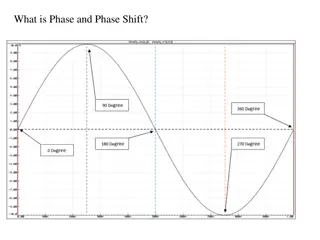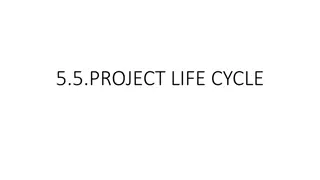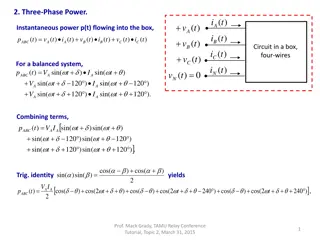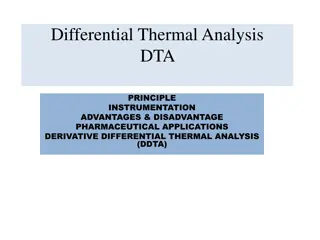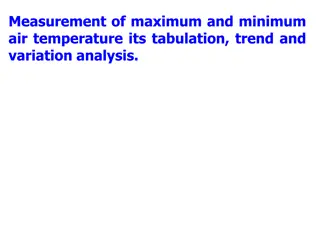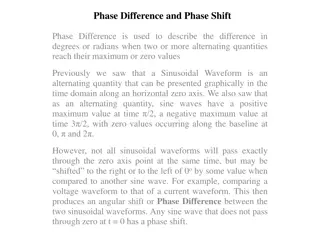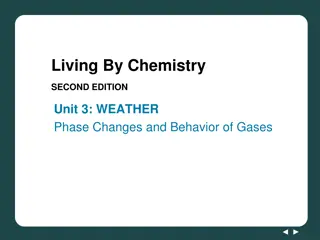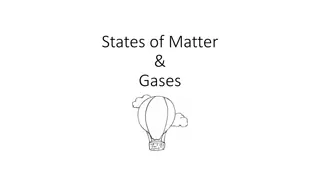Exploring Temperature Changes During Phase Transitions in Water
Analyze temperature changes in water during phase transitions using an external temperature sensor in a hands-on experiment. Understand the molecular order in different states of matter, the role of heat in phase changes, and the influence of pressure on boiling points.
Download Presentation

Please find below an Image/Link to download the presentation.
The content on the website is provided AS IS for your information and personal use only. It may not be sold, licensed, or shared on other websites without obtaining consent from the author. Download presentation by click this link. If you encounter any issues during the download, it is possible that the publisher has removed the file from their server.
E N D
Presentation Transcript
Phase Changes Measuring temperature during phase changes
Phase Changes Measuring temperature during phase changes Objective The purpose of this activity is to analyze temperature changes in water as a result of a physical state transition, formulating an hypothesis about that phenomenon and testing it, using the SensorLab external temperature sensor.
Phase Changes Measuring temperature during phase changes Introduction and theory The aim of the introduction is to focus students on the lesson subject by refreshing acquired knowledge and asking questions which encourage research development. Key concepts from the theoretical framework applied by the students during the lesson are taught. Introduction In our daily life we can observe the different states of matter in which water is found, such as ice, clouds and liquid, that are solid, gas and liquid states respectively. It is remarkable that water is the only chemical compound that can present the three states of matter at normal conditions of pressure and temperature (1 atm, 25 C).
Phase Changes Measuring temperature during phase changes Introduction and theory What is the molecular order in each state of matter? Describe them. What is the name that each state of change receives? What happens with the molecular order when a state of change occurs? Carry out the experiment activity with your class, so that at the end you ll be able to answer the following question: Why are the changes in states of matter produced?
Phase Changes Measuring temperature during phase changes Introduction and theory Theoretical background Heat is another way that energy is manifested. Energy can only be measured as a function of its effect. The caloric energy is also known as thermic energy and can be measured in calories [cal], kilocalories [Kcal] or Joules [J]. The difference between heat and temperature is that heat depends on mass and temperature does not. This is because temperature is the measure of the average kinetic energy of the substance s molecules and heat is the sum of the kinetic energy of the molecules. When a substance absorbs an amount of heat, the velocity of its molecules grows and therefore its temperature rises.
Phase Changes Measuring temperature during phase changes Introduction and theory Caloric energy or heat is responsible for the state changes that matter experiences. The presence or absence of heat makes that matter present solid liquid or gas state, modifying the kinetic energy of the system. Phase change from liquid to gas is influenced by the pressure in the system or in the environment influencing the boiling point and is inversely proportional. In other words if the pressure rises, the boiling point decreases.
Phase Changes Measuring temperature during phase changes Introduction and theory Boiling point is the temperature at which the system reaches the necessary kinetic energy for its molecules to change from a liquid to gas state. During this process, the entire system remains at a constant temperature, as the absorbed energy is used to break bonds, rather than increase temperature. Evaporation and boiling are different concepts. Any liquid substance can evaporate, but not boil. When the system has not yet reached its boiling point, the liquid particles on the surface have enough kinetic energy to evaporate, changing to a gaseous state. At boiling point the whole system has enough kinetic energy for phase change. On the other hand, melting point is the temperature at which a substance changes from solid to liquid. Unlike boiling point, the melting point is not influenced by pressure.
Phase Changes Measuring temperature during phase changes Introduction and theory State change implies a new molecular arrangement, where the attraction forces intermolecular space - and the kinetic energy of the molecules vary as follow:
Phase Changes Measuring temperature during phase changes Introduction and theory These kinetic energy changes are produced by caloric energy previously described. During a state of change the temperature remains constant, however the amount of heat absorbed by the system or substance has changed. Every plateau on the graph shows the exact point where the molecules in the substance increase their kinetic energy to pass to the next phase or state.
Phase Changes Measuring temperature during phase changes Introduction and theory Now students are encouraged to raise an hypothesis which must be tested with an experiment. If there is ice in an open system and the amount of heat starts to increase causing a temperature elevation, what would happen to the ice? Up to which temperature do you think that changes could be observed at the structural level of ice?
Phase Changes Measuring temperature during phase changes Activity description Students will measure the temperature while the phases changes are produced using the SensorLab external temperature probe. They also will relate the temperature variations and the heat transfer in this context.
Phase Changes Measuring temperature during phase changes Resources and materials SensorLab Gensci USB cable External temperature probe 1 beaker (250 ml) Liquid water 1 freezer 1 bunsen burner set Universal stand set 1 clamp
Phase Changes Measuring temperature during phase changes Using the SensorLab a. SensorLab configuration To collect measurements with the SensorLab and IR temperature sensor, the SensorLab must be configured according to the following steps: Turn on the SensorLab pressing . Press , and select SETUP by pressing . Now select the option SET SENSORS with and select external temperature sensor, then press . Once you have done that, you will be back at the setup menu. Press one time and select SAMPLING RATE with . Choose 1/s with and then press . Now, go back to the setup menu and enter NUMBER OF SAMPLES . Select 10000 pressing and press . To come back to measurements press three times. Start measuring with . Once you are finished, stop the SensorLab by pressing (you will see the instruction Press SCROLL key to STOP ) and press .
Phase Changes Measuring temperature during phase changes Experiment The following steps explain how to perform the experiment: Carry out the following steps one day before the experiment: Pour 150 ml of water into the beaker. Submerge the external temperature probe into the water and place the beaker inside the freezer. Be sure the temperature probe stays positioned inside the beaker with adhesive tape, as in the picture below. Carefully close the freezer.
Phase Changes Measuring temperature during phase changes Experiment Experiment: Take the beaker out of the freezer and place it according to the set-up in the picture. Connect the temperature probe to the SensorLab.
Phase Changes Measuring temperature during phase changes Experiment Start measuring by pressing . Light up the burner and observe the physical changes while the solid water is melted. Be sure the temperature probe does not touch the glass walls or the base. When the water has started to boil, wait another five minutes. Finish measuring and stop the SensorLab.
Phase Changes Measuring temperature during phase changes Results and analysis The following steps explain how to analyze the experiment results: Connect the SensorLab to the computer using the USB communication cable or via the Bluetooth wireless communication channel. On the upper menu press and select . Choose the last experiment on the list. Observe the graph on the screen and label the fusion and boiling points using the tool. Select the button to pick up representative values on the graph.
Phase Changes Measuring temperature during phase changes Results and analysis Did you find differences between the registered data and what you expected? Explain. When a phase change is produced, what is the slope of the curve? What do the two plateaus show on the graph?
Phase Changes Measuring temperature during phase changes Results and analysis The graph below should be similar to the one the students came up with.
Phase Changes Measuring temperature during phase changes Conclusions Following are some questions and answers which should be developed by the students in order to elaborate on their conclusions. How could you identify the absorption or release of heat in each phase change? Students should indicate that the temperature variation of a substance allows us to determine the heat transfer. The temperature increase entails the heat absorption and the heat release cause the temperature to decrease.
Phase Changes Measuring temperature during phase changes Conclusions What happens to the temperature during a phase change? Students should point out that the temperature remains constant during a phase change. What happens to the molecular force of water when the temperature rises? Students should indicate that the temperature increase of a substance causes the molecular force to decrease.
Phase Changes Measuring temperature during phase changes Conclusions How would you explain the states of matter progression (solid, liquid and gas) related to kinetic energy of water molecules? Students should point out that the higher the temperature, the greater the kinetic energy of the water molecules. If the temperature decreased the opposite tendency would be observed. The kinetic energy therefore increases as the water is transformed from solid to gas.
Phase Changes Measuring temperature during phase changes Activities for further application The aim of this section is to allow students to extrapolate the acquired knowledge during this class through the application of it in different contexts and situations. Furthermore, it is intended that students present possible explanations to the experimentally observed phenomena. Following are answers to the stated questions. What happens to the liquid water heat inside the freezer? Students should infer that the heat is transferred to the air freezer, decreasing the water temperature and causing the change of matter from liquid to solid
Phase Changes Measuring temperature during phase changes Activities for further application How does boiling point vary with altitude? If you do not know, investigate. Students could suggest that boiling point is affected by pressure conditions. The boiling point is 100 C at sea level. However the higher the altitude, the lower the environmental pressure and the boiling point therefore decreases. How would you explain bubbling when water is boiling? Students should point out that bubbling water is observational evidence for the boiling point and indicates that the whole mass of water is in a process of phase change from liquid to gas. Every bubble is a gas volume released to the environment.




